舟山渔民画:充满浓郁“海腥味”
2022-06-08林上军
林上军
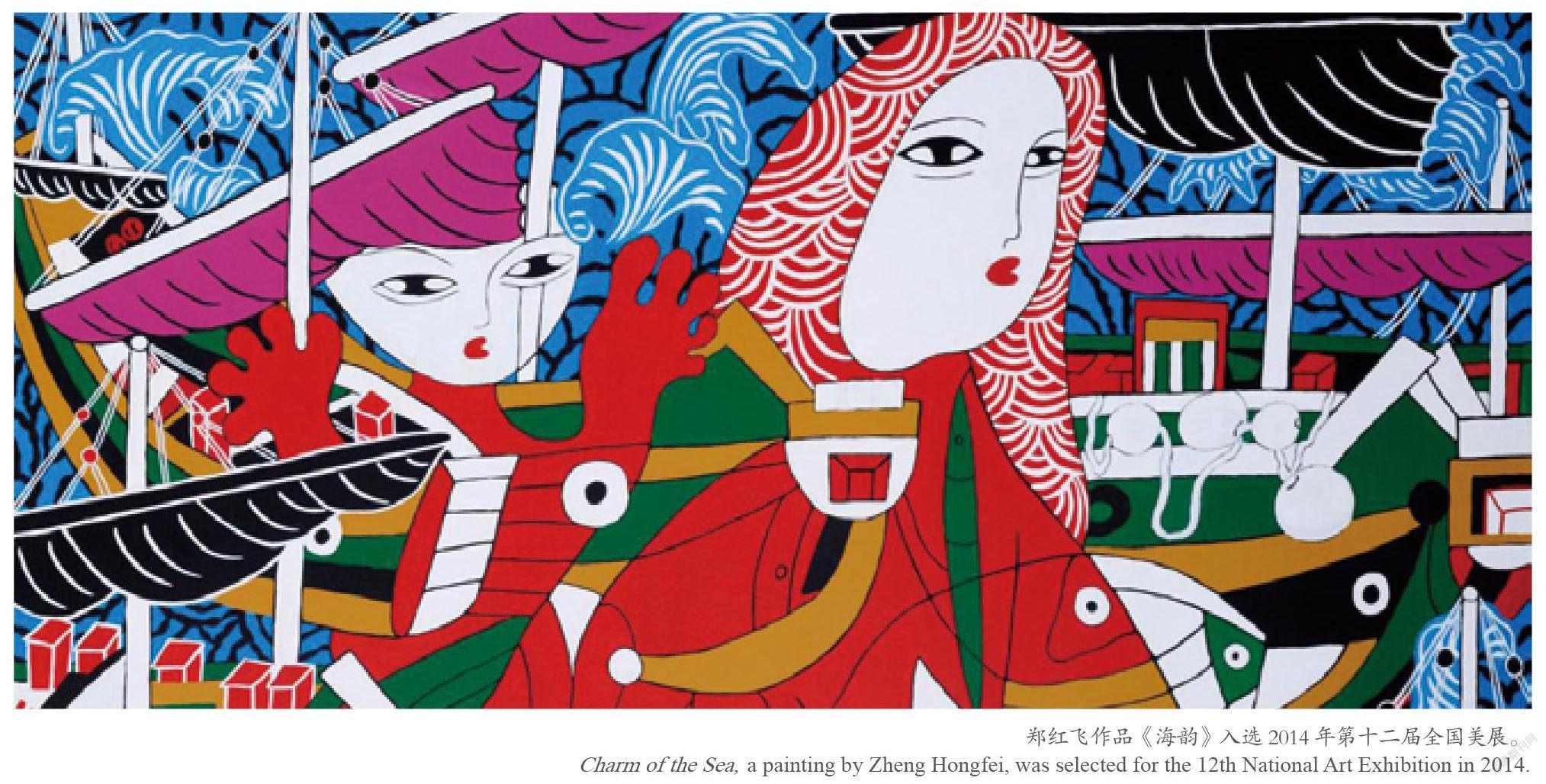
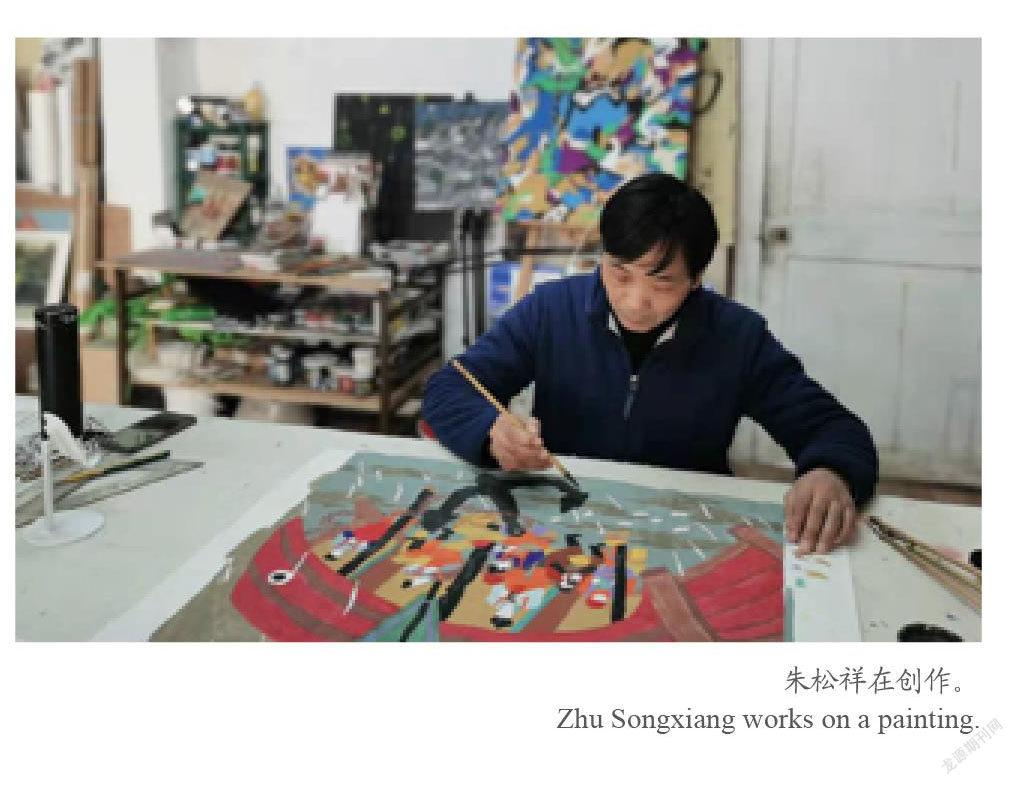
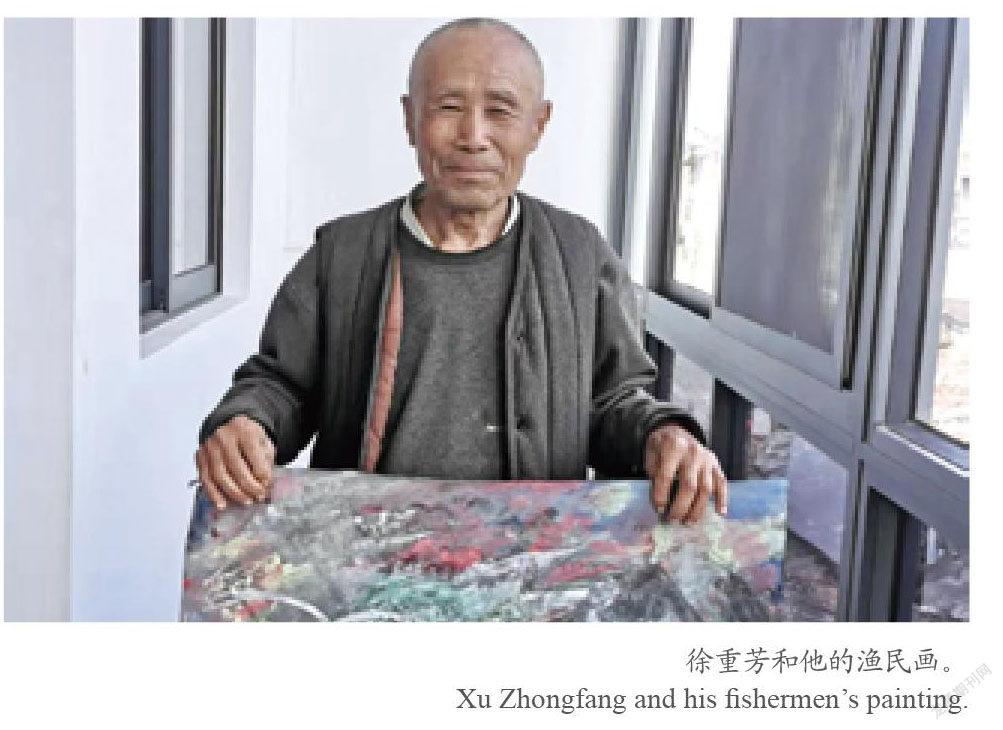
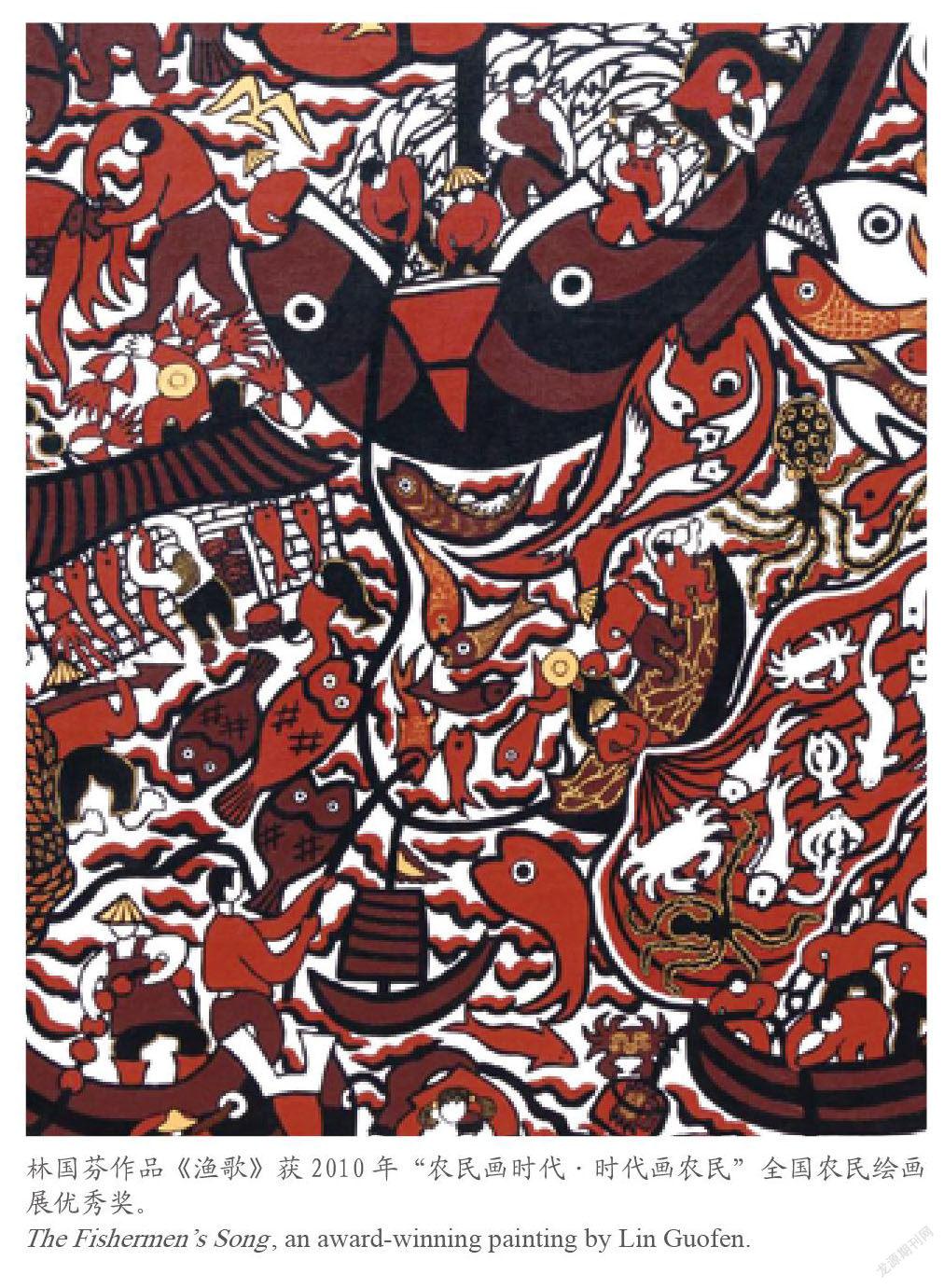
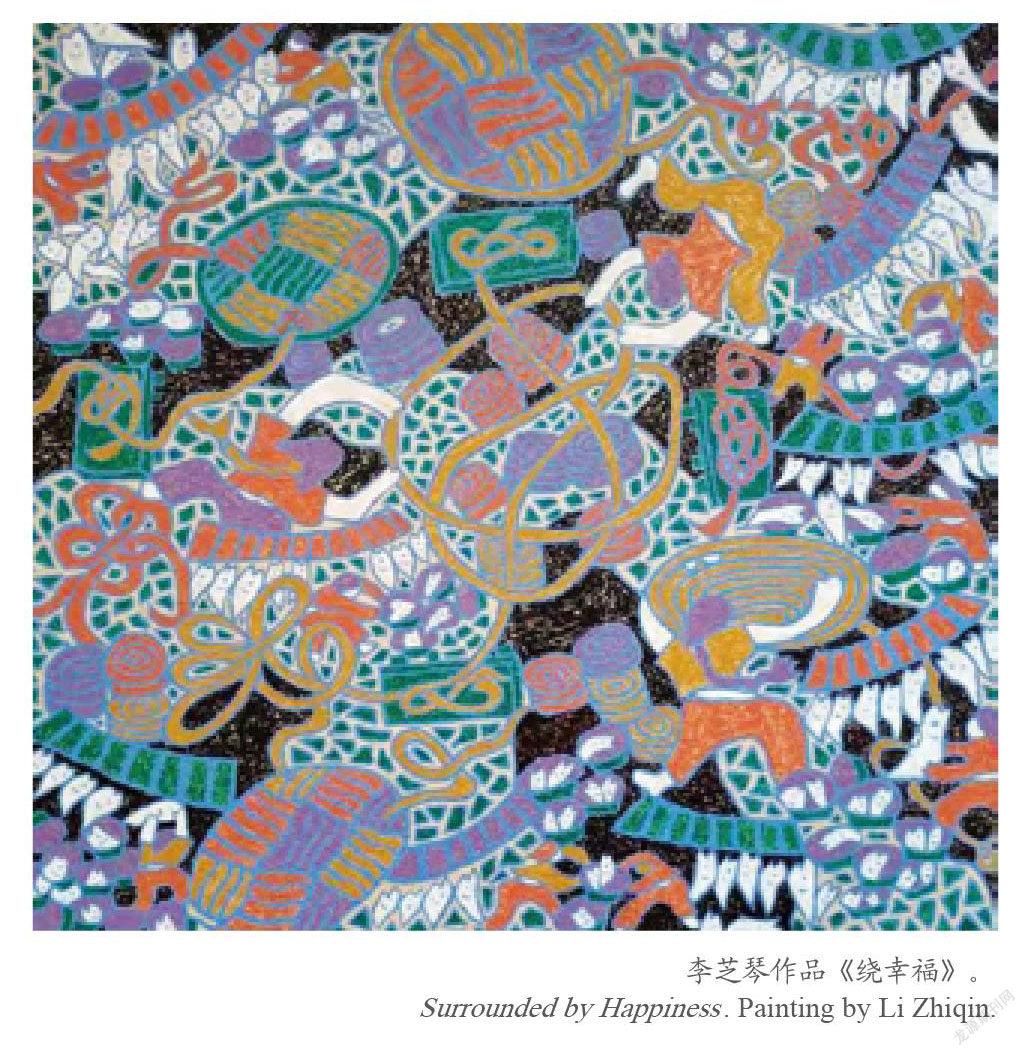

在美丽的东海之滨,坐落着中国第一大群岛舟山群岛,这里也是世界著名渔场。这里有上千个翡翠般的岛屿,生活着一百多万人口,他们中一部分是纯粹的渔民。如今,岛上很多人虽不再从事海上捕鱼,但纯朴、憨厚、豪爽的性格底色已深深地刻进他们的基因里。他们凭借自己的想象,用充满美好愿望的真挚情感以及近乎狂幻的稚拙画笔,描绘了一幅幅反映多样生活、具有奇趣构思、塑造夸张形态、充满神秘感的画卷,这便是舟山渔民画,它已被列入第四批浙江省级非物质文化遗产名录。
渔港边 渔哥渔嫂绘制精品力作
季春时节,草长莺飞。笔者走进位于舟山沈家门渔港边的普陀渔民画创作中心,只见一间间画室内,有渔民和渔嫂在埋头创作。
她叫郑红飞,今年53岁,来自六横岛,从事渔民画创作已有36年。怡静的外表下,有一颗善于想象的心。2020年,她成为当地第一个加入中国美协的渔民画作者。
自幼儿园老师起步,郑红飞凭借自己的天赋和执着,在当地众多渔民画创作爱好者中脱颖而出。1987年,她创作的《城头上挂下的大发》被中国美术馆收藏;2014年和2019年,她的《渔之歌》《海韵》先后入展全国美展,如今她还是当地享受人才津贴的优秀渔民画作者。
200多平方米的普陀渔民画创作中心内,每天总有非遗传承人在潜心创作。张斌恒,渔家后代,今年48岁,原来是海岛上的一名建筑公司的员工,2010年他参加渔民画培训班后,就全身心投入到渔民画创作中,并成立了自己的工作室,做起渔民画销售。
李芝琴,桃花岛人,2005年开始渔民画创作,2010年,她的作品开始走出国门,2014年她成立了自己的画社。如今的她,一有空还经常到各个学校传授自己的手艺。
渔民画家们热爱自己的海岛,热爱自己的劳动和生活,他们以海为动力,依照自己的环境和生活在创作中进行联想,用形象的思维来表达他们朴素的思想情感。他们从客观事物的真实形象出发,进行大胆的创意和夸张,立意奇特,想象丰富,用画笔流露出自己对生活的真情实感和对大海的深情眷恋,作品散发着浓郁的“海腥味”。多年来,普陀渔民画在保持艺术风格整体性的基础上,强调地域特色,力求多样性,创作了一批又一批精品力作。
普陀文化馆美术干部姜声慧介绍,自二十世纪80年代以来,普陀渔民画已有近2000件作品入选全国及省级展览,入编各类画册,入藏多家美术权威机构,并到20多个国家作对外交流展出。2012年,普陀渔民画列入第四批省级非物质文化遗产名录。1988年,普陀区被文化部命名为“中国民間绘画画乡”。继2008年、2011年、2014年连续三次入选“中国民间文化艺术之乡”后,2021年普陀区再次入选2021—2023年度“中国民间文化艺术之乡”。除了沈家门之外,普陀区文化馆还开辟了东极岛、六横岛、蚂蚁岛三个渔民画创作基地,拓展到讲座、培训、参观、研讨等工作,对人才的培养和交流产生积极的作用。 尤其是东极的渔民画创作基地,助推着当地旅游经济、文化产业。
古城内 几十年如一日不离不弃
定海,浙江省屈指可数的海上历史文化名城。厚重的文化底蕴,孕育了一批渔民画创作爱好者。
定海金塘岛上,有两位特别有名的渔民画创作者、传承人——朱松祥、徐重芳。
春日下午,笔者专程拜访他俩。
在金塘柳行老街,朱松祥的“大网头渔民画工作室”格外引人注目。里面摊满了颜料、画纸等各种材料。
朱松祥今年62岁,他的经历丰富奇特:初中毕业后,先后从事篾匠、船工、村镇规划办工作人员、电影放映员、文化站工作人员、漆匠、养兔、开店、螺杆厂负责人等行当工作。尽管角色多变,但业余美术创作一直没放弃 。1987年,他的渔民画《大网头》获得浙江省首届工农画展一等奖。近些年,他的画作先后赴日本、澳大利亚、美国、欧洲等地展出。现在每年有数万元售画收入。
2017年,他退休后,全身心扑在创作上,还带出一批学生。几年下来,他指导的学生在全省书画比赛中多次获奖。
见到徐重芳时,这位八旬老人刚从田头回来,脚穿拖鞋,衣着朴实。如果不熟悉他,没人能想到他是当地有名的渔民画创作者。现在,向他要画的人很多,一幅画至少在一万元以上。
笔者发现,徐重芳的作品略显暗色,但照片拍出来却呈亮色。风格有别于其他渔民画。他说,10多年前,他的画风有比较大的改变,市场上也更加畅销。
自二十世纪80年代以来,他的画作参加全国一系列渔民画展并屡屡获奖。2004年,他被评为全国优秀民间绘画优秀画家;2005年被评为定海区十大民间艺人,2009年被评为浙江省优秀民间人才,2010年被评为中国十大农民画家。
在定海,热爱渔民画的绘画爱好者聚在一块儿,组成了定海“望潮”渔民画群体。群体负责人黄海敏介绍,近年来,定海区文体局依托定海区农村素质提升工程、“百姓课堂”文化公益培训等载体,为基层群众、文体骨干开办渔民画培训班,目前,已拥有了一支稳定性好、综合素质高的“望潮”渔民画群体。此外,该区还组织“望潮”渔民画群体成员到浙江嘉兴秀洲、上海金山等地学习交流农民画,提高作者对民间美术的审美水平及创作水平。
百岛县 斑斓色彩汇成别样风情
有人说,到过“百岛之县”嵊泗,你就知道“海上仙山”绝不是浪得虚名。柔软细腻的沙滩、渔舟穿梭的海面、民风淳朴的渔村、美味无比的海鲜……就如一颗璀璨的明珠,闪耀在万顷碧波之中。而且,那富有韵味的渔民画,会时时扑入你的眼帘,在墙上、在民宿、在村口、在船头,这是嵊泗渔民画作者的风采展示,也是海岛渔村的文气所在。
卢秀绒是嵊泗县第一批渔民画作者,一幅《乌贼夫妻》让她名声大振,成为经典之作,如今一些文创产品上就经常可见这幅画作。
“其实我当时什么绘画功底都没有。”卢秀绒回忆说,1987年,17岁的她参加县文化馆渔民画创作培训班,当时无美术基础的她和其他几位渔家姑娘,经过几个月的磨炼,硬生生完成了一批渔民画作品,而后在上海美术馆展出,不久又到中国美术馆展出。
嵊泗田岙村,典型的渔民画创作基地。外立面能被外人看到的民宿墙上,一幅幅渔民画,瞬间就把人带进了海的世界:渔船上,渔夫使劲拉网,活蹦乱窜的鱼儿,把渔网压得沉甸甸;码头边,渔嫂打着赤脚,挽起袖子忙着拣鱼货;沙滩上,渔家姑娘织渔网,丝线长长,牵系着远洋搏浪的亲人……
2014年,村内打造起一个渔民画创意体验馆,不仅吸引了众多高校美术院系创作团队,更壮大了村内的渔民画创作队伍。现在,一到旅游旺季,这里是游客们的渔民画体验打卡点。而到了淡季,这里则成了渔嫂们的创作基地。
目前,田岙村共有近200户渔家民宿,年均接待游客超9万人次,仅旅游收入就达2000多万元,并成为美术学院嵊泗东海渔村墙体壁画创作基地。
产业化 任重道远踏浪摸索前行
舟山渔民画,尽管兴起于改革开放年代,但其源远流长,最早由古代船饰画演变而来。舟山群岛的先民们在船尾画上泥鳅以象征“龙外甥”,即鱼龙,以镇水妖,避灾祸;在船舱上画“足踏莲花观世音”“龙王献鱼虾”等,以祈保平安丰年。解放后,随着时代的变迁,渔区木帆船变成机帆船,驾驶台门板上都会画上“日出东海”“两龙戏珠”等船饰画。渔家人独特的生产生活方式、多姿多彩的民俗风情,成为渔民画题材的宝库,可以说,舟山丰富深厚的民间传统美术正是滋养渔民畫之树能够根深叶茂的丰厚土壤。
近年来,随着国家对非物质文化遗产的重视,舟山渔民画先后被列入浙江省民间艺术保护一二三批名录;2006年12月,舟山渔民画被列入“首批市级非物质文化遗产代表作名录”,2012年7月,普陀渔民画被列入省级第四批非物质文化遗产名录。
蘸海为墨,踏浪而行。这几年,舟山渔民画产业化进度有所加快,2014年,舟山渔民画产业协会成立,56家企业和个人画坊成为会员单位。“当年,渔民画文创产品仅有二三十种,现在有二三百种。”协会会长张高俊,是当地有名的画家,作品多次参加中国美展。日前,笔者走近他的画室,只见他又在制作新的文创产品,用剪纸将渔民画展现出来,再进行装裱,而且内容也融入了舟山海天佛国元素。
服饰、鞋类、箱包、饰品、扇子……如今的舟山渔民画文创产品几乎无所不包,产值已从2014年的50万元增加到400万元。每年,张高俊都会带着大家外出参观考察交流。渔民画家蒋德叶年收益二三十万元。有的渔民画工作室试着将鹅卵石、贝壳等作为绘画的载体,创作家居摆设品,并推出渔民画DIY创作活动,受到了市场的欢迎。
最近,张高俊正在摸索渔民画提升工程,他尝试将渔民画颜料、材质由普通的一般化颜料改为油漆、板材,如此让渔民画有了一种立体感,也提高了收藏价值。
舟山市美术家协会副主席、舟山渔民画协会会长朱国安说,自二十世纪80年代以来逐渐兴起的舟山渔民创作群体,虽有潮起潮落态势,但整体在变强,人员在增加。舟山渔民画以大胆的艺术想象和强烈的生活气息,又通过造型上的夸张、随意和色彩上的艳丽、强烈,成为颇受欢迎的渔民画种,每次参展获奖率总是名列前茅。他希望政府能强化渔民画知识产权保护,加大文创产品销售窗口建设,加强渔民画产业链建设和创新人才培养,让舟山渔民画产业行稳致远。
Zhoushan Fishermen’s Paintings:
Full of Local Flavors
By Lin Shangjun
On the coast of the East China Sea lies Zhoushan, China's largest archipelago and world-famous fishing ground. Home to more than a million inhabitants, Zhoushan is a collection of over a thousand islands. Today, many Zhoushan people no longer fish for a living. With their rich imagination, their good wishes, as well as their authentic feelings, they have painted pictures of all sorts of colors, interesting ideas, touching expressions, exaggerated shapes, and grotesque and mysterious conceptions. They are known as “fishermen's paintings”, which have been inscribed on Zhejiang’s provincial intangible cultural heritage list.
Walking into the Putuo Fishermen's Painting Center near the Shenjiamen Port in Putuo district, Zhoushan city, one is immediately struck by the scene fishermen and fisherwomen immersed in painting in one painting room after another. The 53-year-old Zheng Hongfei, from Liuheng Island, has been painting for 36 years. With a quiet demeanor, Zheng is full of imaginative power. In 2020, she became the first local fisherman artist to join the China Artists Association.
Starting as a kindergarten teacher, Zheng stands out among fellow fishermen painters with her talent and dedication. In 1987, one of her works was collected by the National Art Museum of China. In 2014 and 2019, her Song of Fishing and Fishing in the Sea were showcased in national art exhibitions.
Zhang Binheng is another fisherman painter working in the 200-odd-square-meter center. The 48-year-old Zhang used to be an employee of a local construction company and became a full-time painter after attending a training course for fishermen painters in 2010. He has set up his own studio and is now selling his paintings. Li Zhiqing started to make decorative fishing knots in 2005, and her works have been exported abroad since 2010. She now gives lectures from time to time, teaching her craft and skills to local students.
These fishermen artists love their home islands, as well as their life and work. Over the years, nearly 2,000 paintings by artists from Putuo have been seen in international, national, provincial exhibitions, painting albums and collections of arts institutions, according to Jiang Shenghui, an official with the Putuo Cultural Center. Apart from the studio at the Shenjiamen Port, the Putuo Cultural Center also set up three painting bases for fishermen painters, which have been instrumental in promoting local tourism and cultural industry.
In neighboring Dinghai district, fishermen painters can be found as well. On its Jintang Island, 62-year-old Zhu Songxiang has a unique life story. After graduating from middle school, he took up jobs as a bamboo weaver, a boat worker, a village planner, a film projectionist ... and he has never stopped painting in the process. In 1987, his painting Big Fishing Net won the first prize in a provincial exhibition. In recent years, his works have been exhibited in Japan, Australia, the United States and Europe. Currently, Zhu earns tens of thousands of dollars every year from selling his paintings. Since 2017, he has devoted himself to painting after retirement, even training his own students, who won numerous honors in various competitions held in Zhejiang.
For those who haven’t heard of Xu Zhongfang before, they could have easily taken him for their avuncular neighbor. The octogenarian is a well-known fisherman painter in the area. A piece of his painting could fetcher for at least 10,000 yuan or $1,500. Since the 1980s, Xu has participated in myriad national exhibitions for fishermen’s paintings and won multiple awards. In 2009, he was named as one of the Top Ten Farmer Painters in China.
In Dinghai, fishermen art enthusiasts have created their own painting society. Huang Haimin, who is in charge of the society, said that local authorities have organized regular training and programs on fishermen’s painting in recent years for the members of the society.
It is said that one needs only to set foot on Shengsi, known as a “county with a hundred of islands”, one will understand its reputation as a “fairyland on the sea”. Soft and delicate sand beach, fishing boats shuttle on the sea, delicious seafood ... More eye-catching are the fishermen's paintings full of fishing charm: on the wall, in the guesthouses, at the entrance of the villages and at the bow of the boat … you can find them everywhere.
Lu Xiurong was among Shengsi’s first fishermen painters. A Squid Couple, a painting by Lu in 1987, has made her famous and become a classic of fishermen’s paintings.
“I hadn’t learned anything about painting at all,” she recalled her experience of attending a training class in 1987, when she was 17 years old, for fishermen’s paintings at the county cultural center. She and some other fishing girls, who had no next-to-nothing art knowledge or technique, finished a group of fishermen’s paintings after several months of intense training, which were then exhibited in the Shanghai Art Museum and later in the National Art Museum of China.
Tian’ao village in Shengsi county is itself a base for fishermen’s painting. On the walls of homestays, a series of fishermen's paintings instantly bring people into the world of the sea: on the fishing boat, the fishermen pull the net hard, jumping fish weighing down the net; by the wharf, fisherwomen are busy picking up fish with bare feet; on the beach, girls are weaving fishnets ...
In 2014, the village set up a creative experience hall themed on fishermen's paintings, attracting not only those from art institutions, but also more villagers to take up painting. During peak seasons, it is a place for many tourists to try their hands on fishermen's painting. In the off-season, it serves as a painting base for locals.
At present, nearly 200 households in Tian’ao village have opened homestay business, receiving an average of more than 90,000 tourists annually and earning over 20 million yuan.
While modern fishermen’s painting as a genre emerged in the 1980s, its origins go a long way back in history. In ancient times, Zhoushan’s fishermen already began to paint on their boats auspicious symbols and sea creatures, such as Avalokitesvara to pray for peace and prosperity. It is the rich traditional folk art tradition that has given rise to fishermen’s painting as we know today.
In recent years, moves have been taken to make it into an industry. In 2014, the Industrial Association for Zhoushan Fishermen’s Painting was established. “Only 20 or 30 kinds of cultural derivative products from fishermen’s paintings used to be made,” said Zhang Gaojun, president of the association and a well-known local painter. “Now you can easily see 200 or 300 kinds.” From apparel and shoes to handbags and accessories, fishermen’s paintings can be found on various cultural and creative products, the total value of which increased from 500,000 in 2014 to four million. More efforts are still needed for the long-term and steady development of the fishermen’s painting industry, said Zhang, in particular raising awareness on intellectual property rights, opening sales channels for related products and cultivating more talents.
